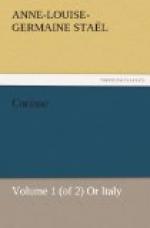Corinne, among her innocent stratagems to vary the amusements of Oswald, had still in reserve the statues and the paintings. One day therefore, when Oswald was perfectly restored, she proposed that they should go together to see the most beautiful specimens of painting and sculpture that Rome contains. “It is a reproach,” said she to him, smiling, “not to be acquainted with our statues and our pictures; so to-morrow we will commence our tour of the museums and the galleries.”—“It is your wish,” answered Nelville, “and I agree. But in truth, Corinne, you have no need of these foreign resources to retain me; on the contrary, it is a sacrifice that I make whenever I turn my eyes from you to any object whatever.”
They went first to the Museum of the Vatican, that palace of statues where the human figure is deified by Paganism, in the same manner as the sentiments of the soul are now by Christianity. Corinne directed the observation of Lord Nelville to those silent halls, where the images of the gods and the heroes are assembled, and where the most perfect beauty seems to enjoy itself in eternal repose. In contemplating these admirable features and forms, the intentions of the Deity towards man, seems, I know not how, to be revealed by the noble figure which He has been pleased to give him. The soul is uplifted by this contemplation to hopes full of enthusiasm and virtue; for beauty is one and the same throughout the universe, and under whatever form it presents itself, it always excites a religious emotion in the heart of man. What poetic language, there is in those countenances where the most sublime expression is for ever imprinted,—where the grandest thoughts are clad with an image so worthy of them!
In some instances, an ancient sculptor only produced one statue during his life—it was his whole history.—He perfected it every day: if he loved, if he was beloved, if he received from nature or the fine arts any new impression, he adorned the features of his hero with his memories and affections: he could thus express to outward eyes all the sentiments of his soul. The grief of our modern times, in the midst of our cold and oppressive social conditions, contains all that is most noble in man; and in our days, he who has not suffered, can never have thought or felt. But there was in antiquity, something more noble than grief—an heroic calm—the sense of conscious strength, which was cherished by free and liberal institutions. The finest Grecian statues have hardly ever indicated anything but repose. The Laocoon and Niobe are the only ones which paint violent grief and pain; but it is the vengeance of heaven which they represent, and not any passion born in the human heart; the moral being was of so sound an organization among the ancients, the air circulated so freely in their deep bosoms, and the order politic was so much in harmony with their faculties, that troubled minds hardly ever existed then, as at the present day.




